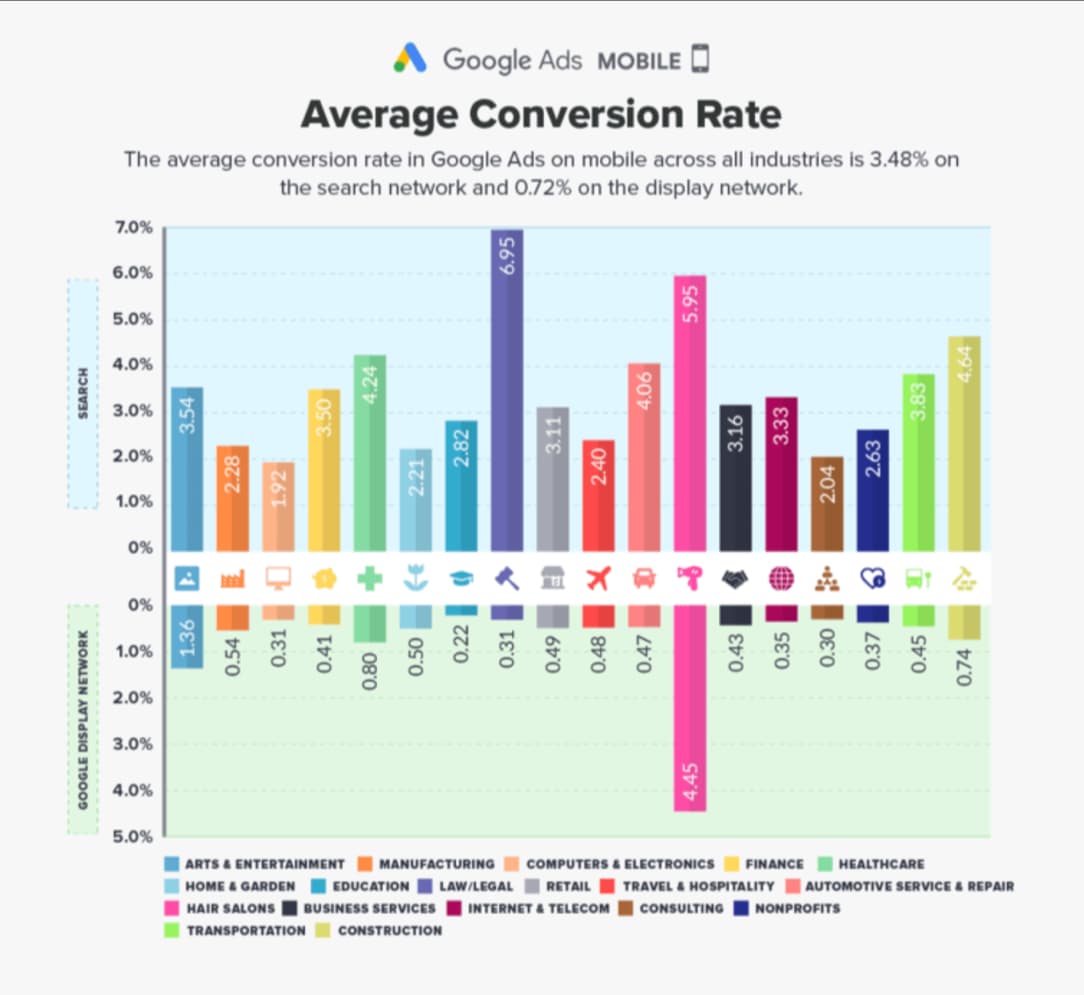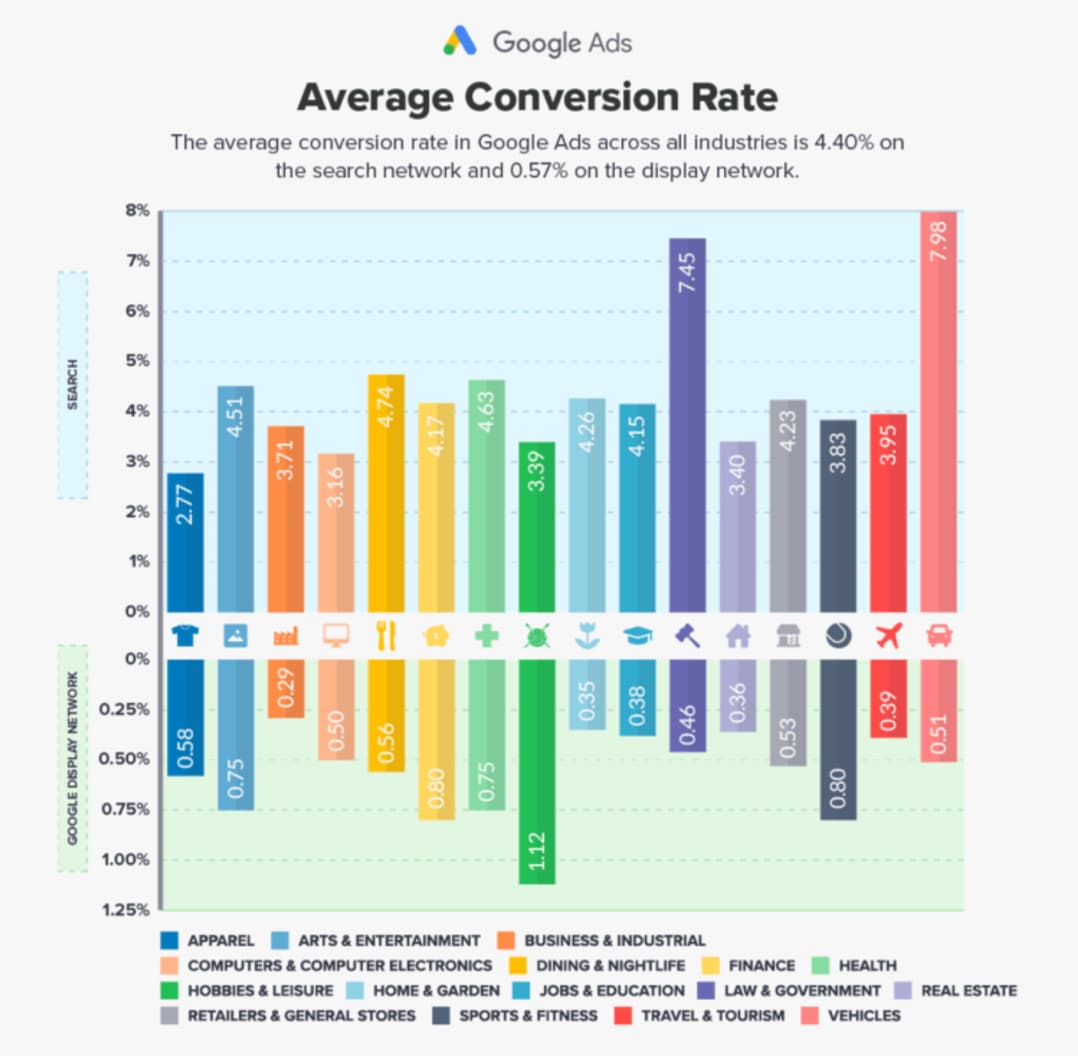Welcome to the world of digital marketing, where understanding the nuts and bolts of your campaign's performance is key to success. If you're delving into paid ads, one term you'll frequently encounter is "What is a Good Conversion Rate For Google Ads?" It's a crucial metric that can make or break the effectiveness of your advertising efforts. As a conversation optimization expert, I'm here to guide you through what a good conversion rate looks like for paid ads and how it can dramatically shift your business towards more significant achievements.

Understanding Conversion Rates
What is a Conversion Rate?
For instance, if your ad campaign had 1,000 visitors and 50 of them completed a purchase, your conversion rate would be 5%. This number is a beacon of your ad's effectiveness, guiding you towards understanding how well your ad resonates with your audience.
Why is Conversion Rate Important?
Conversion rate stands as a cornerstone of your advertising strategy for several reasons. First, it directly correlates to your return on investment (ROI). A higher conversion rate means more revenue or desired actions per visitor, optimizing the money you spend on ads. Secondly, understanding your conversion rate helps in benchmarking your performance against industry standards and competitors, allowing you to strategize more effectively. Lastly, it acts as a feedback mechanism, providing insights into user behavior and preferences, enabling you to refine and tailor your advertising efforts for better performance.
Remember, while conversion rates provide invaluable insights, they don't exist in a vacuum. They are influenced by various factors including your industry, target audience, and the specific actions you're measuring. As you continue reading, keep in mind that a "good" conversion rate is relative and varies widely across different contexts.
Industry Benchmarks for Paid Ads

Average Conversion Rates Across IndustriesWhen trying to determine what a "good" conversion rate is for your paid ads, it's beneficial to start by looking at industry benchmarks. These averages provide a yardstick for comparison, helping you understand where your campaign stands against others in your sector.
Here are some general figures for average conversion rates across various industries:
- E-commerce: 1-2%
- Real Estate: 2-3%
- Travel: 4-5%
- B2B: 2-3%
- Healthcare: 3-4%
These numbers are just starting points. Many factors such as product type, ad quality, and market competitiveness can influence these averages. For instance, luxury goods might have a lower conversion rate due to their high price point, but they also bring in more revenue per conversion.
According to the search results, the average conversion rate for paid search ads across all industries is 3.2% to 4.2%. However, the conversion rate varies depending on the industry. For example, the Dating & Personals industry has the highest paid ad conversion rate at 9.64%, while Advocacy has the lowest at 1.96% .To track conversions and traffic from paid ads on a website, you can use UTM URLs, Google Analytics, and custom events. Google Ads offers different ways to track conversions, including measuring web conversions from Google Analytics 4 and measuring app conversions from Google Analytics 4.Here are some key points from the search results:
- The average conversion rate across all industries is 3.2% to 4.2% for paid search ads.
- The highest paid ad conversion rate is in the Dating & Personals industry at 9.64%.
- The lowest paid ad conversion rate is in the Advocacy industry at 1.96% 1.
- UTM URLs, Google Analytics, and custom events can be used to track conversions and traffic from paid ads.
- Google Ads offers different ways to track conversions, including measuring web conversions from Google Analytics 4 and measuring app conversions from Google Analytics.
- According to emailsearch, a good conversion rate for google ads is around 3.75%.
Why Industry Benchmarks Matter
Understanding industry benchmarks is crucial because it sets realistic expectations and helps in goal setting. If your conversion rates are significantly below industry averages, it might indicate issues with your ad strategy or user experience. Conversely, if you're exceeding these averages, you're likely on the right track and should analyze what's working well to replicate it in future campaigns.
Factors Affecting Conversion Rates for Paid Ads
Ad Quality and Relevance: The quality of your ad content and how relevant it is to your target audience dramatically affects conversion rates. High-quality, engaging ads tailored to the interests and needs of your audience are more likely to convert. This includes compelling visuals, persuasive copy, and a clear, enticing call-to-action.
Targeting and User Intent: Your targeting strategy is crucial. Are you reaching the right people? Understanding user intent and aligning your ads with the audience's stage in the buying process can significantly improve conversion rates. For instance, targeting users who have already visited your website with retargeting ads can lead to higher conversion rates than targeting new users.
Landing Page Experience: Once a user clicks your ad, the landing page they arrive at must deliver on what the ad promised and guide them towards the conversion. A well-designed, fast-loading landing page that's consistent with the ad's message and easy to navigate can significantly boost conversions. Key elements include a strong headline, relevant content, a clear call-to-action, and an effortless checkout or sign-up process.
External Factors: External factors such as seasonality, economic conditions, and changes in consumer behavior can also impact conversion rates. For instance, retail businesses might see higher conversion rates during the holiday season.
In conclusion, while industry benchmarks provide a helpful context, it's crucial to understand the various factors that can affect your conversion rates. By continuously optimizing ad quality, targeting, and the user experience, you can improve your performance and strive towards achieving and surpassing industry averages. Stay tuned as we delve into strategies to determine and enhance your specific business's conversion rates.
How to Determine a "Good" Conversion Rate for Your Business
Relativity of 'Good' Conversion RatesThe idea of a "good" conversion rate is subjective and varies significantly from one business to another. To determine what's good for your specific situation, consider the following:
- Industry Averages: Start with the benchmarks provided earlier but remember they are just a guide. Your business might naturally fall above or below these numbers due to unique factors.
- Historical Data: Look at your past performance. If your current conversion rate is higher than before, you're likely making progress.
- Business Objectives: Align conversion rates with your business goals. If you're meeting or exceeding the set objectives, your conversion rate can be deemed good for your purposes.
Continuous Monitoring and ImprovementA "good" conversion rate is not a static number. It requires continuous monitoring and tweaking. Regularly analyze your conversion data, test different strategies, and make informed adjustments to maintain and improve your rate over time.
Strategies to Improve Conversion Rates
Improving conversion rates is an ongoing process of optimization and refinement. Here are some strategies to consider:
1. A/B Testing:Experiment with different elements of your ads and landing pages to see what works best. Test variations in copy, design, calls to action, and more to incrementally improve your conversion rates.
2. Enhancing User Experience:Ensure that the user journey from ad click to conversion is as seamless as possible. Optimize your landing pages for speed, clarity, and ease of navigation. Make sure your site is mobile-friendly and loads quickly to reduce bounce rates.
3. Personalization:Tailor your ads and landing pages to the specific needs and interests of your target audience. Use data to create more relevant and engaging experiences that resonate with your users.
4. Strong Calls-to-Action (CTAs):Your CTAs should be clear, compelling, and easy to find. Use action-oriented language and make it obvious what you want the user to do next.
5. Creative Content:Invest in high-quality, engaging content that captures attention and persuades users to take action. This might include videos, infographics, high-quality images, or well-written copy.
6. Offer Incentives:Sometimes, users need a little extra push. Consider offering discounts, free trials, or other incentives to make taking the next step more appealing.
7. Retargeting:Use retargeting ads to reach people who have already interacted with your brand but didn't convert. They're more likely to convert than first-time visitors.
By implementing these strategies and continuously refining your approach based on data and results, you can work towards achieving and maintaining a good conversion rate for your business. Each small improvement can lead to significant growth over time, so commit to ongoing optimization and watch your results improve. Stay tuned for real-life case studies and examples that illustrate these strategies in action!
FAQs on Conversion Rates for Paid Traffic
1. What defines a conversion in paid traffic?
- In the context of paid traffic, a conversion is defined as a specific action that a user takes after clicking on a paid advertisement. This could be making a purchase, signing up for a newsletter, downloading an app, or any other predefined action that aligns with your business objectives.
2. How do I track conversion rates for my paid ads?
- Conversion rates for paid ads can be tracked using various analytics tools. Most advertising platforms like Google Ads or Facebook Ads provide built-in conversion tracking features where you set up specific conversion actions and the tool tracks and reports the data for you.
3. What factors can influence conversion rates in paid advertising?
- Several factors can influence conversion rates, including the quality and relevance of the ad, the targeting precision, landing page design and content, the user experience, and even external factors like market trends or seasonality.
4. How can I tell if my conversion rate from paid traffic is effective?
- To determine the effectiveness of your conversion rate, compare it against industry benchmarks, assess it in the context of your cost per acquisition, and consider it alongside other metrics like overall ROI. A conversion rate that's cost-effective and contributes positively to your business goals is generally considered effective.
5. Why might my conversion rates vary between different paid traffic sources?
- Different platforms cater to different audiences and intentions. For example, users on LinkedIn might have a different mindset compared to users on Instagram, affecting how they respond to your ads. The platform's ad format, targeting capabilities, and user base can all cause variations in conversion rates.
6. How do seasonality and market trends affect paid traffic conversion rates?
- Consumer behavior often changes based on the season, holidays, or current events, affecting conversion rates. For example, retail might see higher conversion rates during the holiday season, while other industries might have specific peak times. Staying aware of these trends and adjusting your strategy accordingly can help maintain or improve conversion rates.
7. How important is A/B testing in improving conversion rates for paid traffic?
- A/B testing is crucial as it allows you to compare different versions of your ads or landing pages to determine which performs better in converting users. Regularly conducting A/B tests can lead to incremental improvements in your conversion rates over time.
8. What's a realistic improvement goal for conversion rates from paid traffic?
- Realistic goals for improving conversion rates depend on your starting point, industry averages, and the effectiveness of your optimization strategies. Aiming for a 10-20% improvement is generally realistic, but goals should be tailored to your specific context and continuously adjusted based on results.
9. When should I be concerned about my paid traffic conversion rates?
- Be concerned if you see a sudden drop in conversion rates or if your rates are consistently below industry averages and negatively impacting your ROI. It's also concerning if despite efforts in optimization, there's no improvement in conversions.
10. Can targeting adjustments lead to better conversion rates in paid traffic?
- Yes, refining your targeting strategy can significantly improve conversion rates. By ensuring your ads are seen by users who are most likely to be interested in your product or service, you can increase the relevance and effectiveness of your ads, leading to higher conversion rates.

